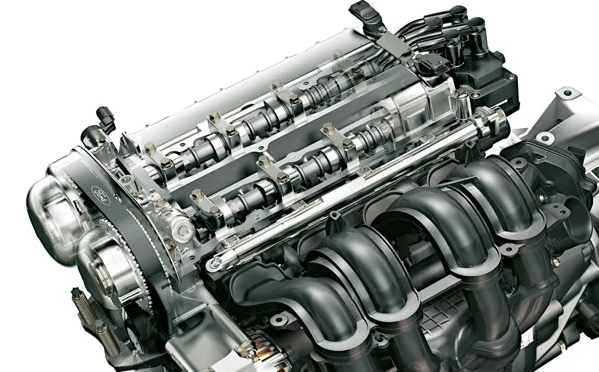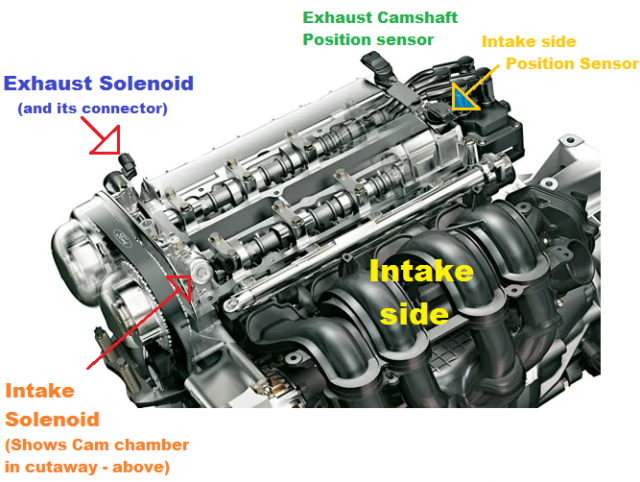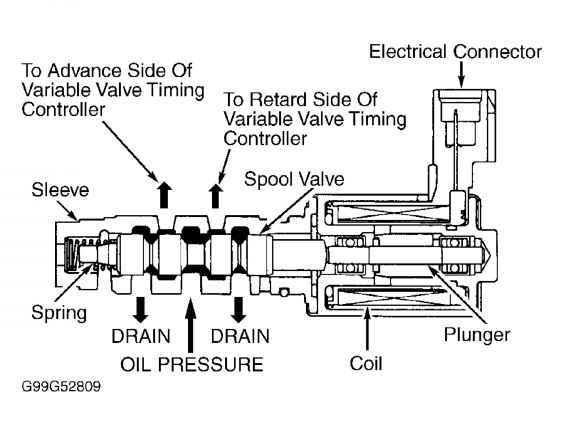Check the wiring harness - replacing the water pump I hope you didn't "pinch" a wire?
Usually, the loom prevents this but it's easy enough to "torque off" a connector or two in a harness trying to push, press the harness out of the way to get at what you needed to do.
When it "lacks power" it could also be something as simple as a vacuum leak - so check the PCV and EGR (If it's auto - you mentioned park - check EGR)
After reviewing this, this post and poster deserves more detail...
Ok, the USA version of the Fiesta has a 1.6L version of the SIGMA motor - which has a special ability to advance timing on it's twin cams - and independently from each other to develop power is ways not possible with previous generations.
So that means you'll need to know how those Cams get the ability to do that in the first place.
The motor otherwise is the basic combustion engine.
They use two chambers located on the Cams

- The cover that houses the timing belt also contains the two chambers that are used to advance-retard-change the valve timing. The belt rolls over the gear that contains the oil chamber that fills and empties of oil depending upon how the system determines the need for power. These chambers are part of the Cam design - that; when they fill with oil - the cams move or rotate to either advance or retard their timing (Lobe position in the turn of rotation or angle) using a set of ports to fill chambers that use vanes as a method of gaining energy from the oils viscosity and ability to displace as a fluid to apply that pressure to move those lobes on the cam to let the valves take in air or let out exhaust earlier than otherwise possible with a fixed cam and the gear timing setup.

- To control those vanes; oil, being under pressure from the engine, is used. Ports let the oil flow in and out - they are controlled by a set series of Solenoids - two of them - one for each cam. Those Solenoids operate as requested by the PCM or Power Control Module that operates the engine.

- The solenoids operate a set of ports to fill those chambers with oil
- When the Solenoids energize - the port aspect changes - oil under pressure then flows following the port.
- The pressurized oil has volume and the cams use vanes that rest on the cams that if not filled - simply are closed off and follow-rotate along with the timing belt.
- The space between the vanes, when the oil flows into them - that space fills with the oil under pressure - forcing the vanes and the cam they are attached to - to move.
- Since oil is displacing by pressurizing the chamber
- - that volume then forces the cams to move in a direction - forward, to ADVANCE the timing of the valves to let more air in or exhaust out - changing the duration of the time the valves are open and closed affecting the engines ability to accelerate and decelerate.
- The Cams only move so far to advance the cam lobes - so the volume of oil is relatively small, but the pressure and it's viscosity is the force that applies tension to the cam thru the vane - to make it move per the solenoid. But the timing belt still moves the cam as a unit.
- When the Solenoids are not powered - the oil pressure doesn't stop, but the port closes and the oil inside the cams vaned chambers, that pressure is released. Since the cam does move - spins - the oil begins to drain back into the engine and by using the cams own friction of rolling over the valves - then forces those vanes to attain rest into a closed or retarded position.
Once you understand the complexity of the cam and the timing it can operate under and as a function to control the combustion chamber contents - the timing issue them becomes more clear.
So the next time you have to work on your motor anywhere near the timing belt or serpentine belt be sure to rotate the crank bolt CLOCKWISE - with the engine powered off - two full turns = by manual effort - by using a long arm socket wrench on the Crank Pulley bolt to turn the crank by hand.
You do not need to spin it fast, in fact - don't! Let the rotation occur slow - gently so you don't force the oil pump to begin developing pressure and send oil up to those ports if the solenoids were not seating properly - else you'll have to determine another approach to replacing the defective solenoid that's leaving the ports open for oil to circulate - if that is the case.
Why?
- so you can make sure those vanes and the chambers they are in are emptied back into the motor and that there is no residual advance or retard timing conditions left in the upper cams
- - that they are SEATED in the full retarded position.
- To accomplish that,
- requires the motor to be turned off and allowed to cool down and let the oil drain back into the oil pan.
- To add:
- to avoid compression stroke issues, you can even remove the spark plugs to let the engine turn far more easily. You may need to do this anyways as a part of the tune up and replacement of the Water Pump and valve cover gaskets - just remember to reinstall the spark plugs before you use the Starter.
- Best to do this when the engines' Battery is disconnected - then you have just you and the motor.
- Best to let the system do an Idle relearn procedure once the system has been fully repaired.
- As a sidebar to this, the best way to let the engine know you're in a learning mode,
- is to insert the key,
- Turn the key to ON (not Start) then OFF (all the way off not out)
- Do this eight times in succession - leave the key ON on the 8th time
- This is done - to put the vehicle in "learn mode"
- Leaving the key in ON position - turn to Start and let the engine run for at least 10 minutes.
- Let the engine warm up - then once all the repaired area has been checked for leaks - if none found - drive the vehicle in normal traffic for 10 minutes and observe operation - this may need a OBD Code scanner to help you diagnose any specific engine condition if the Check Engine light and trouble with erratic operation of the engine is found during this test.



